IBM Master Program Clock; Metal Disc Type (1933)
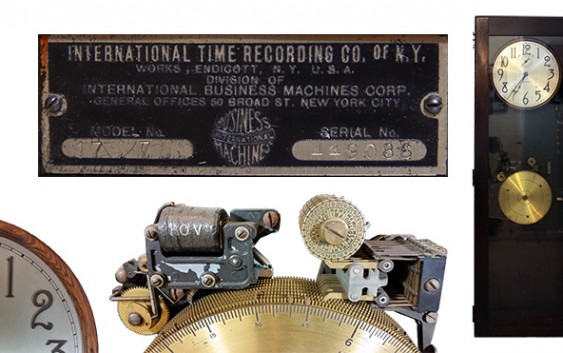
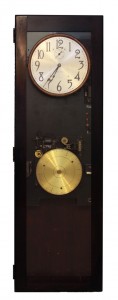
Few things give me joy like acquiring a piece that has a hallmark, patent number, serial number or model number. For me collecting is getting to understand the past, and having these time markers usually means with a little research I can put the item into a larger historical context. This IBM Master Program Clock; Metal Disc Type circa 1933 is a great example of research paradise.
Business equipment is one of those really fun areas because everything is so well documented. Especially IBM equipment. Riding on the back of the industrial revolution, when IBM formed there was a well-established practice of marking everything with a serial and model number. From the serial number you can determine down to the year the when item was manufactured and often find the old manuals online indicating purpose and operation.
This IBM Master Program Clock is one such piece. First step was to look for International Business Machine (IBM) and time clock. Thanks to a general search I was able to find out it was a Master Program Clock. From there I was able to find the IBM history page which has just about every major piece IBM made going back to 1916 (thank you bean counters!). From the model number, 17, and description I fund a document that identified the piece as an IBM Master Program Clock; Metal Disc Type. Once I had the correct name, I found a document that listed the shipping dates based on a serial number range. Serial number 449086 was produced in 1933!
Condensed List of IBM Clocks and Related Products
Appraising and Dating Your Clock
This completely makes sense. This is one of the loveliest and scariest pieces of equipment I have collected.
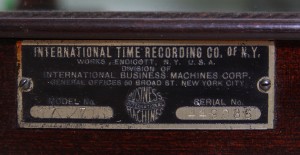
Historical Context for 1933
To put this piece into historical context.
- The Great Depression was in full swing (1929 – late 1930s).
- When shipped, we were six years away from World War II.
- Nazi Germany announces withdrawal from League of Nations
- 1st issue of “Newsweek” magazine published
- 1st major league All-Star Game announced for July 6 at Comiskey Park. It will be played as part of the Chicago World’s Fair
- 1st synthetic detergent, “Dreft” by Procter & Gamble, goes on sale
- Albert Einstein arrives in US, a refugee from Nazi Germany
Information liberally lifted from History Orb
What the Heck is a Master Program Clock?
Simply put, it rang bells that ran throughout a complex at set intervals. It’s hard to believe, but when I started work for a state agency in Texas in the early 1980s, they actually used a modern version of this piece. A bell rang for a shift start, lunch begin / end and end of the day. And of course, who could not forget the school bells that rang for the various daily sessions. Vive la recess.
More on operation below.
When Style Mattered
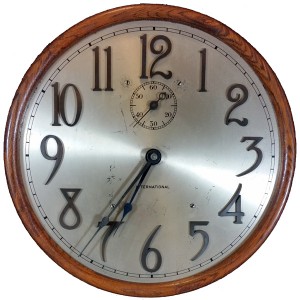
One of the most striking features of this machine is the clock face. Look at how the numbers go beyond function. I personally like the 2, 8 and 4. Notice how the 8 almost looks like an hour glass and how they took the time to angle the cut on the 4. Who does that on a piece of business equipment? I would love to see where these were actually hung. I can imagine this being placed somewhere workers could actually see it.
I also appreciate the brass control plates. Looking at this model, the plates appear to be brass, but it is hard to tell if they are solid brass. I have seen later models in worse condition and the brass has come off to expose a metal undercoating. In any event, these are beautiful to look at and still retain their original shine.
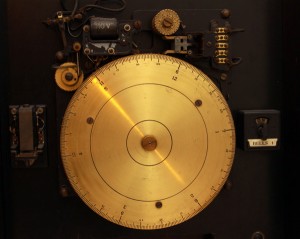
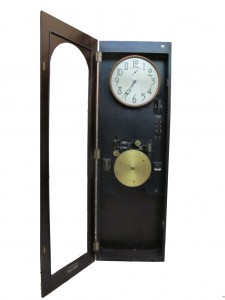
And finally, the wood case has a beautiful glass front displaying the clock face and dials. Similar business clocks from the 50s’ hide the workings and at most display a plain clock face.
Terrifying to Operate
Ok, clearly the industry was just developing safety standards. The case is equipped with locks on the side for a good reason. The machine uses open switches. There only thing between you and electrocution is a small knob used to make the circuit. This is also why I have never tried to run it. The clock is complete with fuses and wires that are in relatively good condition.
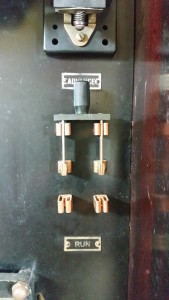
Device Operation
From a casual glance you get the general operation principle. There are pins inserted into the large discs at the bottom. As they rise, each pin will push up a switch which completes a circuit. The circuit provides electricity to bells. Now go deeper.
How the heck to you set this thing? The clock appears to be for quick glance reading. The real time setting operation is controlled by the gears below.
The small wheels are clearly marked with the days of the week, AM / PM and divides the day into 4 chunks (Midnight, 6 am, 12 PM, 6 PM). The large wheel below, refines the time into 24 hours. So here is where my head starts hurting. You put a pin in the small wheel to activate the day and block time you want to set an alarm. There are 8 disks giving you 7 possible settings (pins go between the discs). There are 9 large hour / minute discs below giving you 8 rows to set actual bell ringing pings. When the small day pin engages the switch the first part is activated. When the large wheel pin engages the second switch the circuit is complete and electricity runs to the bell.
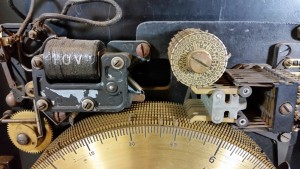
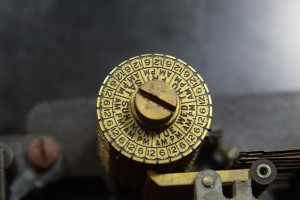
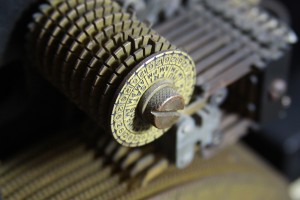
So how do you align the clock and the three discs?
Good grief. There is a “run” and “advance” setting along with a way to kill the bells. Being to chicken to plug it in, I will have to take an educated guess. It appears that if you set the mechanism to advance, it will increase the voltage and everything will progress very fast. Imagine you setting the time on a clock. You pull the stem and advance it quickly in order to get it to the correct date and time. Few issues with this concept:
- The clock and the wheels below would have to be perfectly aligned from the manufacturer. If the clock was off, there is no apparent way to resynchronize them. I.e. there is no stem for the clock. There is a scary looking circuit below that may play into the resolution of the issue.
- If you were setting the time and overshot, you would have to advance all seven days to get back to your desired position.I am convinced that is how this part of the mechanism works. The switches are hook shaped and look like they only go one direction. Plus there is no reverse switch.
In summary, I was a bit sad that we have progressed to the point that we can solve just about any problem with a bit of code and a few generic boards from China. But upon further reflection, I do not think humanity’s desire to marry function and form has really diminished. If you look at an iPad, Android phone or any of the modern wonders, you can see the same drive to create something functional and visually appealing. I also feel that my Master Program Clock lives on in my modern technology through the evolutionary process. I just set an appointment on my Android phone… Day, Hour, Minute. I like to imagine I just stuck a couple pins in 17 little virtual discs ready to complete the circuit and alert me that I late for my meeting.